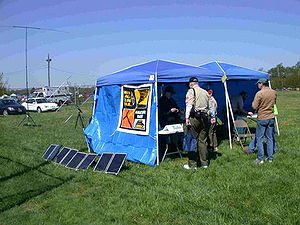

In times of crisis and natural disasters, amateur radio is often used as a means of emergency communication when wireline, cell phones and other conventional means of communications fail.
Unlike commercial systems, amateur radio is usually independent of terrestrial facilities that can fail. It is dispersed throughout a community without "choke points" such as cellular telephone sites that can be overloaded.
Amateur radio operators are experienced in improvising antennas and power sources and most equipment today can be powered by an automobile battery. Annual "Field Days" are held in many countries to practice these emergency improvisational skills. Amateur radio operators can use hundreds of frequencies and can quickly establish networks tying disparate agencies together to enhance interoperability.
Recent examples include the September 11 attacks on the World Trade Center in Manhattan in 2001, the 2003 North America blackout and Hurricane Katrina in September 2005, where amateur radio was used to coordinate disaster relief activities when other systems failed. In 2017, the Red Cross requested 50 amateur radio operators be dispatched to Puerto Rico to provide communications services in the wake of Hurricane Maria.[1]
On September 2, 2004, ham radio was used to inform weather forecasters with information on Hurricane Frances live from the Bahamas. On December 26, 2004, an earthquake and resulting tsunami across the Indian Ocean wiped out all communications with the Andaman Islands, except for a DX-pedition that provided a means to coordinate relief efforts.[2]
Recently, amateur radio operators in the People's Republic of China provided emergency communications after the 2008 Sichuan earthquake[3] and U.S. hams did similar work following Hurricane Ike.[4] Amateur radio operators provided communications in the aftermath of the Boston Marathon bombing when cellphone systems became overloaded.[5]
The largest disaster response by U.S. amateur radio operators was during Hurricane Katrina which first made landfall as a Category 1 hurricane went through Miami, Florida on August 25, 2005, eventually strengthening to Category 5. More than a thousand ham operators from all over the U.S. converged on the Gulf Coast in an effort to provide emergency communications assistance. Subsequent Congressional hearings highlighted the Amateur Radio response as one of the few examples of what went right in the disaster relief effort.[6]
- ^ Murphy, Paul P.; Krupa, Michelle. "Ham radio operators are saving Puerto Rico one transmission at a time". CNN.com. CNN. Retrieved 29 September 2017.
- ^ Pasricha, Anjana. "Ham Radio Operators Become Lifeline for Tsunami-Stricken Indian Islands". VOA News. Voice of America. Retrieved 2 October 2017.
- ^ "Chinese Officials Give Kudos to Amateur Radio Operators". American Radio Relay League. 2008-05-27.
- ^ "Texas Hams Braced for Ike". arrl.org. ARRL. Retrieved 2 October 2017.
- ^ Solomon, Dave. "Marathon 'hams' took on vital role after Marathon bombings". Union Leader. New Hampshire Union Leader. Archived from the original on 3 October 2017. Retrieved 2 October 2017.
- ^ "ARRL COO Testifies on Capitol Hill to Amateur Radio's Value in Disasters". ARRLWeb. American Radio Relay League, Inc. 3 Oct 2005. Retrieved 17 February 2010.